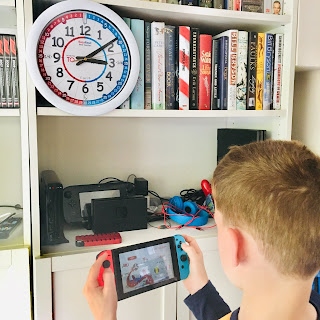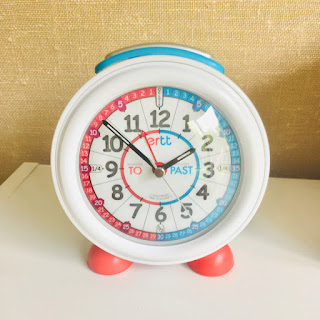Telling the time is a skill that I take for granted. So much of our lives rely on being able to organise yourself, from getting to places on time, understanding how long things are going to take, and when you need to leave your house to get to there.
But time is a very strange concept given that dictate so much for our lives. Although apparently a constant, it often seems like current time goes quicker or slower depending on what we are doing. Time travels fast when you are having fun - as my mum (and now I) says all the time. This all adds to the complication of understanding time and for kids like mine, who have autism and ADHD, understanding about time and reading it can be quite challenging.
Of all the things in the early curriculum that our eldest son struggled with, telling the time was a occurring issue. Just when we thought he'd cracked it, he'd get out of practice and not be able to do it again.
In many ways I'm not surprised. It's different from all the rest of maths - I’ve never really understood why there are 60 minutes seconds and minutes 60 minutes in an hour and 24 hours in a day. It doesn’t seem to make sense - everything else is in ones, tens and hundreds. It feels like being made to deal in shillings and old pence when you've got used to the decimal system.
So how can I help my kids understand it?
The basics
Understanding that time passes is a simple step to take to start with. Our younger autistic son, David, lives very much in the present. When he’s enjoying something he sees no end to it stopping and it only finishes when all of a sudden he doesn’t want to do it anymore. Letting him know that things do finish and is important thing. The we started this idea is by using a Now & Next board.
This is really simple pictorial board that shows one activity followed by another. You can buy some really good Now & Next boards with symbols already set up for you. You can also make one yourself.
As activities are completed they can be removed. Then the 'next' activity moves into the 'now' spot. A new activity could be added to the 'next one. So for example, we could have an image of an iPad in the 'now' box and 'dinner' in the next box. When it's time to move from playing to eating, we can take down the iPad image and move the dinner one to the left. We have supported this using Makaton too.
Perhaps we could then add a new activity such as a bath or bed to the board to indicate what's going to happen next. The Autism Page has information on how this can also be used as a motivator.
It provides a natural progression and once the child is happy with a now and next board they can run onto a fuller sequence. Soon you can organise a whole day of activities and the kids will understand that they will be from one activity to another. This can be particularly beneficial for kids like our with autism who feel safer knowing what is going to happen. It can help take uncertainty out of their day.
Associating times of day with activities
Once a child can understand that things happen at one after the other, you can try and associate different times of the day with the activities or events. For example school starts at nine o’clock and finishes after three o’clock. We have lunch at noon. We go to bed at 7pm. Knowing that we get up at 7am later will help the kids learn to stay in bed until it says this on their clock. These create labels for children and they start to understand and associated the particular numbers and phrases with parts times of their routines.
Telling the time
Anthony had a perfect understanding of days and sequences. He knew all of the above but actually when it came to telling the time he really struggled. Reading a clock face requires looking at lots of information and translating it into meaning.
There is also the different language associated with the different ways people tell the time. Do I collect the children from school at quarter past three or three fifteen and that's before you add in the whole 24 hr thing. This can be confusing too if you aren't sure of how time is broken down yourself.
The best tool I’ve had for learning to read the time, is an EasyRead Time Teacher clock. It comes with a really easy three step process that breaks down areas of the clock so that as you see them speak them and then you can tell the time. To read the time in minutes-past and minutes-to the hour the child;
- Reads the number at the end of the long hand
- Says which side the long hand is pointing to (past or to)
- Reads the number at the end of the short hand.
It's given Anthony much greater confidence in telling the time both in analogue and digital. He finds it easier to translate between reading the time on his phone and on one of these clocks. We have a minutes-past and minutes-to version wall clock, he has a 12/24 watch and we're just trying out an alarm clock in his shared room.
He usually works so well with numbers and constants so I'm hoping this immersion will cement reading the time for him too. There are a range of helpful tell the time games to play to reinforce this using the same type of clock faces which may work for you too.
Win an EasyRead Time Teacher Alarm Clock
Features a crescendo alarm, snooze button, dim and bright night light, which helps with knowing what the time is and if they should still be in bed, and silent hands so there's no annoying ticking. For full details click here.
Conditions: UK Residents only. Entrants must be aged over 18. Entry is via Rafflecopter. Entries can be made up until midnight on 5th July as indicated above . One winner will be chosen from all valid entries at random the day after closing. The winner will be contacted within a week of the closing date and have one week to respond. The Prize is one EasyRead Time Teacher Alarm Clock as shown above. Prize is sent direct from ERTT. The exact clock of the could change with an alternative product of similar or higher value sent included. No cash alternative.
This post supports the Makaton #wetalkmakaton sign of the week 'Now'. It's one we use a lot in our home, why not learn it?
We have our own ERTT wall clock and got Anthony an ERTT watch in his stocking this year. We were also sent the EasyRead Time Teacher Alarm Clock for to try before including one in the giveaway.
As always my posts are independent and all opinions our own.
As always my posts are independent and all opinions our own.






Great ideas. I love that there are a range of helpful tell the time games as well.
ReplyDeleteThey are great ideas - fun ways to help children learn to read the time!
ReplyDeletethis would be ideal for granddaughter who is just learning to tell the time.
ReplyDeleteThese are fab - no ambiguous big and little hands -
ReplyDeleteI loved reading the article and these are great ideas, my youngest has a speech impediment so struggles to get accross telling the time. This clock would be a great help as it gives her the words she can sound out.
ReplyDeleteI think these ideas are very good and I like how straightforward the clock is, it will be easy for children to understand.
ReplyDeleteVery good, Autism is very complex.
ReplyDeletefabulous ideas! great for children with SEN
ReplyDeleteSuch great ideas
ReplyDeleteThese are brilliant ideas
ReplyDeleteWhat brilliant ideas, and the clock looks great to get my daughter used to alarms!!
ReplyDeleteA fabulous teaching aid as well as being useful.
ReplyDeleteThese are really good ideas to help children
ReplyDeleteThese are a great idea to help children with telling the time as it something they can struggle with!
ReplyDeleteThank you, my son is 13,he so struggles with all concepts of time. This may help him. Love your posts - you make so much sense - from from asd mum to another
ReplyDeleteMy parents learned English as a second language, so when I was young, I never really learned to 'tell time' or at least say it right. Plus digital clocks were all the rage. I had a very good teacher that helped me during recess. We are all teachers in some capacity as we all influence young people & can all teach them things. Thanks for the opportunity.
ReplyDeleteThis is definately my kind of blog post! My eldest is at the age of taking an interest in what time we do what things and I feel something like this would be so so helpful in her learning. Thanks for sharing. #KCACOLS
ReplyDeleteHi Ann, I’m not sure if my comment earlier got through, so trying again now. I wanted to thank you for all these great ideas, especially as this is something I need to work on with our (autistic) son. Time can be such a tricky concept, quite abstract and difficult to grasp. Thank you for linking up with #KCACOLS, hope you come back again next time!
ReplyDeletebrilliant idea my two boys are just about ready to lern to tell time so this is perfect
ReplyDeleteThis is a great idea and its something that we have introduced to the little lady. Thank you so much for joining us for #KCACOLS and we hope see you next time!
ReplyDeleteLove these tips.Our 9year old son has just started leatming the time in school and these ideas will come in handy ..Michelle Mccall
ReplyDeleteLots of these ideas would be handy to use with my son as I really struggle to get him to bed x
ReplyDeleteI like how the clock has different areas to make it easier to tell the time and also the games to play to help
ReplyDeleteWould love to w8n for my grandson
ReplyDeleteI like the way the clock makes it easier to know when to say "past" and "to", and has the number of minutes written in digits.
ReplyDeleteBy the way, if I remember correctly, it was the Ancient Egyptians who decided on 60 seconds in a minute, 60 minutes in an hour and 7 days a week, which is a quarter of a lunar month (28 days). Don't know why this system has never been modernised to use multiples of 10 which would be so much easier.
Good ideas. Learning to tell the time comes gradually, yet is so worthwhile.
ReplyDeleteRachel Craig
I love the idea of the Now and Next board. We just got one of the same clocks that you mention and it has really helped my kids. Thanks for sharing with the #DreamTeam
ReplyDelete